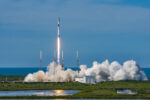According to Forbes’ Carlie Porterfield, the first-ever collected sample of moon dust will be auctioned in New York on April 13 against the desires of the National Aeronautics and Space Administration. In a news release, the auction firm Bonhams predicts that the Apollo 11 moonwalk specimens might sell for between $800,000 and $1 million. A portion of the money raised will be donated to scientific organizations in need.
According to Rebecca Heilweil for Vox, this is the first time NASA-verified moon dust will be sold legally, despite the space agency’s attempts. In the decades after the 1969 Apollo mission, NASA has fought to keep the lunar dust out of the hands of private citizens, resulting in several legal cases against people who have somehow received samples from NASA. NASA has prevailed in many of these challenges, but the Bonham auction dust samples’ ownership claims burst through the legal barriers after NASA lost a series of court fights.
Armstrong, Aldrin, and Collins launched the historic Apollo 11 mission to put men on the moon on July 16, 1969. Astronauts Armstrong and Aldrin were sent by NASA to the moon’s surface in the Lunar Module, where they were charged with bringing back lunar samples for further research. First, save the moon rocks, they said to us. One bag of rocks is all we have. History cites Mike Mallory of the Apollo 11 frogman rescue crew as saying, “We have a lot of astronauts.
The moon dust was returned to the Cosmosphere space museum in Hutchinson, Kansas, where it was safely preserved in a contingency bag. However, as Artnet’s Caroline Goldstein recounts, the museum’s then-director, Max Ary, was subsequently found to have unlawfully auctioned off NASA-loaned space objects. The bag of space dust was recovered by the U.S. Marshals Service after Ary was convicted in 2005.
In a lot that included featured an Apollo command module headrest and a launch key for the Soviet Soyuz T-14 spacecraft, the U.S. Marshalls auctioned off the bag, and geology enthusiast and lawyer Nancy Lee Carlson paid $995 to get it. Carlson mailed the bag to NASA in 2015 because she thought the lunar dust was worth more than she paid for it. Despite NASA’s confirmation that the moon dust was genuine, the agency has refused to return it, claiming that it is government property.
Carlson’s lawsuit against NASA ended in a loss for NASA since the judge presiding over that case ruled that Carlson was entitled to retain the bag because she purchased it. According to Artnet, Carlson sold the bag at Sotheby’s in 2017 for $1.8 million, unaware that it was missing part of the moon dust she had initially bought
As a test, NASA employed carbon tape to gather moon dust traces, which they transferred to a pair of metal discs that the agency kept even after returning their luggage. In the end, NASA agreed to return most of the moon dust when Carlson re-used it for damage to the bag and theft. In 2017, she auctioned off the samples for $1,812,500 in a Sotheby’s auction.
As reported by Artnet, the Jet Propulsion Laboratory and Army Ballistic Missile Agency will be auctioning off an Explorer 1 nose cone and an aluminum component from Sputnik 1 as part of a space-themed auction later this month.
The “Billionaire Space Race” featuring the likes of Elon Musk, Jeff Bezos, and Richard Branson has “stirred up the market” for space stuff, says Adam Stackhouse, the Bonhams expert organizing the auction.
There was something about this story that gripped the globe, according to Stackhouse. “And what about the rest of the assignments?” It’s different. People aren’t as excited about it.” More than a pound of moon dust is presently in existence throughout the world, according to Vox. The Soviet space program gathered dust samples in 2018 and sold them for $855,000. The 2020 lunar rover mission of China’s Chang’e spacecraft acquired roughly 4 pounds of moon dust samples.




